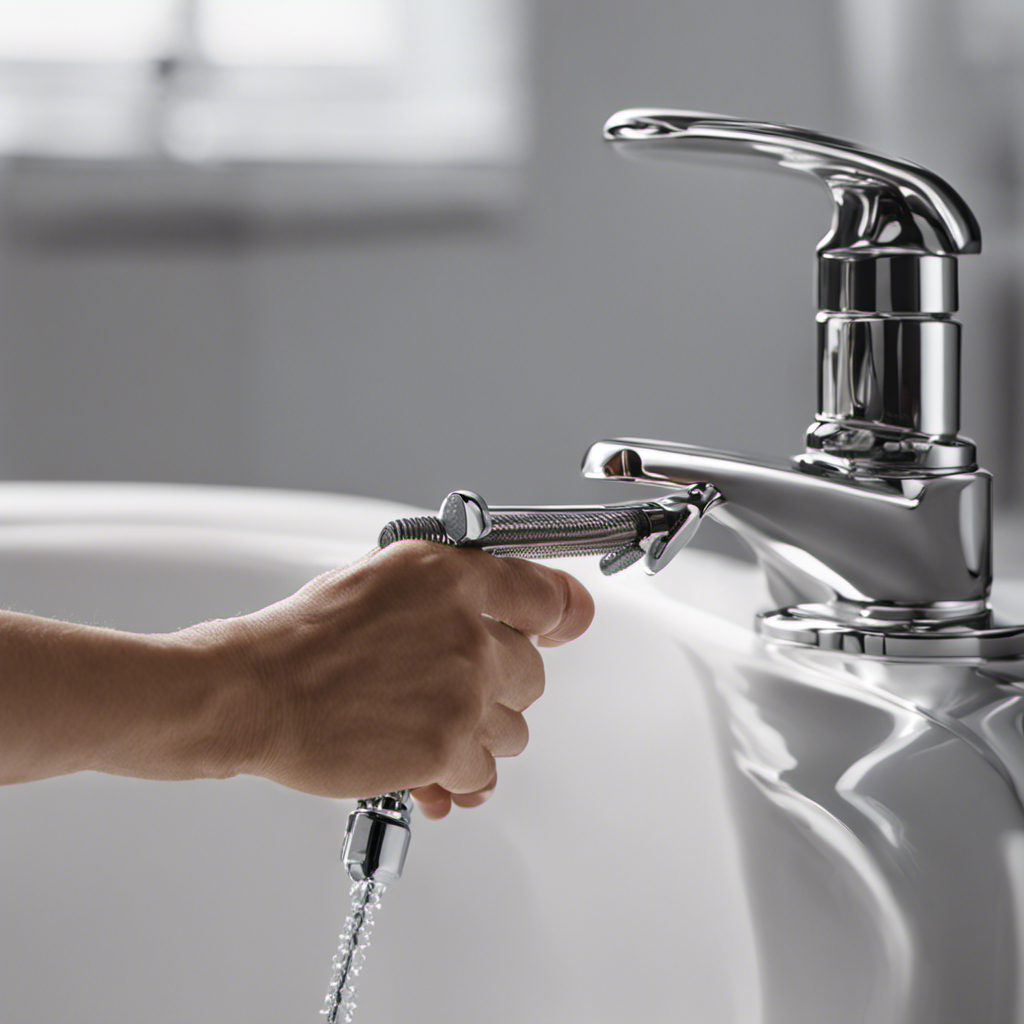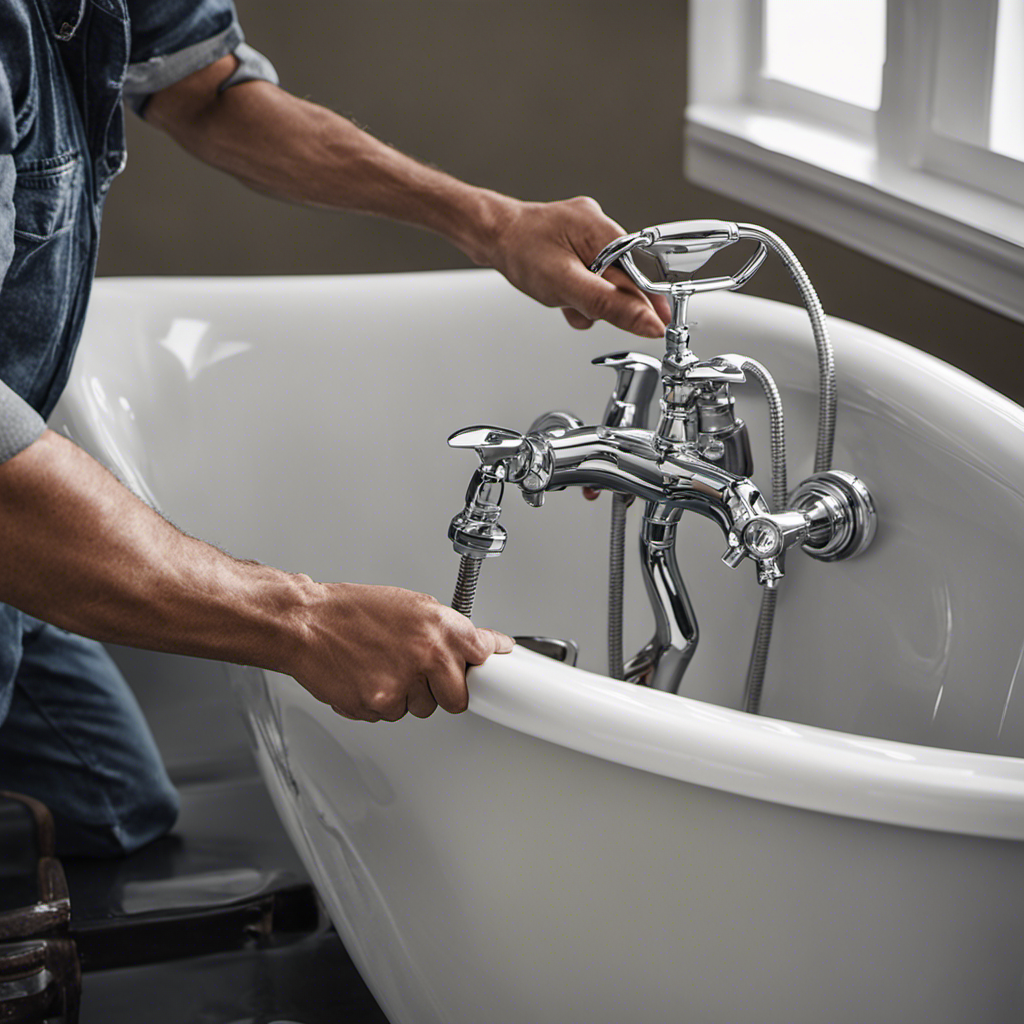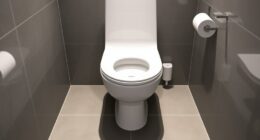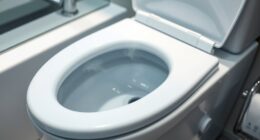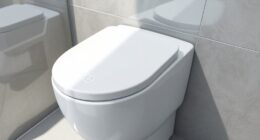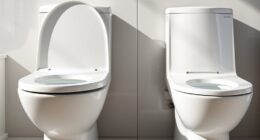Are you tired of standing in ankle-deep water every time you take a shower? Well, you’re not alone. Did you know that over 80% of homeowners experience slow bathtub drains at some point?
But don’t worry, there’s a solution! In this article, we will guide you through the steps to fix your slow bathtub drain, from identifying the problem to seeking professional help if needed.
Say goodbye to clogged drains and hello to a smoothly flowing shower experience.
Key Takeaways
- Over 80% of homeowners experience slow bathtub drains at some point.
- Common causes of a slow bathtub drain include a buildup of hair and soap scum in the drainpipe.
- Using natural remedies like baking soda and vinegar can help unclog the drain.
- If DIY methods don’t work, it’s important to seek professional help for a thorough solution.
Identifying the Problem
To start, let’s figure out what’s causing the slow drain. There are several common causes for a slow bathtub drain.
One of the most frequent culprits is a buildup of hair and soap scum in the drainpipe. Over time, these substances can accumulate and create a blockage that restricts the flow of water.
Another possible cause is a clogged vent pipe. This can cause air pressure issues and prevent the water from draining properly.
Signs and symptoms of a slow drain include water pooling in the bathtub, a gurgling sound when the water is draining, and a foul odor coming from the drain.
Now that we have identified the problem, let’s move on to the next step of clearing debris from the drain.
Clearing Debris From the Drain
First, you’ll want to remove any debris from the drain to improve drainage speed. Start by removing the drain cover or stopper. Use a flashlight to inspect the drain and locate any visible debris, such as hair or soap scum. Using a pair of tweezers or needle-nose pliers, carefully pull out any visible debris that may be causing the clog. Be thorough in your search, as even small pieces of debris can contribute to a slow drain.
Once you have removed the visible debris, run hot water down the drain to flush out any remaining residue. To prevent future clogs, consider using a drain cover or strainer to catch hair and other debris before it enters the drain. Regularly cleaning the drain with DIY drain cleaning techniques, such as using a mixture of baking soda and vinegar or a plunger, can also help maintain optimal drainage.
Using Natural Remedies to Unclog the Drain
Once you’ve located the visible debris, you can use a mixture of baking soda and vinegar to naturally unclog the drain.
Natural remedies are a great alternative to chemical drain cleaners, as they are safe for both you and the environment.
Baking soda and vinegar create a chemical reaction that helps break down the clog and restore water flow.
Start by pouring a cup of baking soda down the drain, followed by a cup of vinegar.
Let the mixture sit for about 30 minutes, allowing it to fizz and dissolve the clog.
Afterward, flush the drain with hot water to wash away any remaining debris.
To prevent future clogs, remember to avoid pouring grease, hair, and large objects down the drain.
Regularly using a drain strainer can also help catch debris before it enters the pipes.
Using a Plunger to Remove Blockages
Using a plunger is an effective way to remove blockages and restore water flow in your clogged drain. Here are some steps to follow when using a plunger:
- First, make sure there is enough water in the bathtub to cover the rubber part of the plunger.
- Position the plunger over the drain and push down firmly to create a seal.
- Begin plunging up and down vigorously for about 20-30 seconds.
- Release the plunger and check if the water is draining properly.
If the blockage persists, you can try alternative methods such as using a drain snake or a mixture of baking soda and vinegar. To prevent future clogs, remember to:
- Avoid pouring grease or oil down the drain.
- Use a drain strainer to catch hair and other debris.
- Regularly clean your drain with a mixture of hot water and dish soap.
- Consider pouring boiling water down the drain once a month to prevent buildup.
If the issue persists even after trying these methods, it may be time to seek professional help to ensure a thorough fix.
Seeking Professional Help for Persistent Issues
When the blockage persists, it’s time to consider seeking professional help to ensure a thorough solution. While DIY methods can be effective for minor drain issues, persistent bathtub drain problems may require the expertise of a professional plumber.
Seeking alternative solutions is important when you have exhausted all the effective DIY methods. Professional plumbers have the knowledge and tools to diagnose and resolve complex drain issues, ensuring a long-lasting solution. They can use advanced techniques such as hydro jetting or drain snakes to remove stubborn clogs that may be causing your slow bathtub drain. Moreover, they can inspect the plumbing system to identify any underlying issues that could be contributing to the problem.
Don’t hesitate to reach out to a professional for help when your bathtub drain problem persists.
Frequently Asked Questions
How Can I Prevent My Bathtub Drain From Getting Clogged Again in the Future?
To prevent your bathtub drain from clogging again, take preventive measures like using a drain cover and regularly cleaning the drain. If the problem persists, it’s best to call a professional drain cleaning service for thorough assistance.
Can I Use Chemical Drain Cleaners to Unclog My Bathtub Drain?
You can use chemical drain cleaners to unclog your bathtub drain, but be aware of the pros and cons. Consider alternative methods like using a plunger or a drain snake, which may be safer and more effective.
Is It Possible for My Bathtub Drain to Get Clogged Due to Issues With the Plumbing System?
It’s frustrating when your bathtub drain gets clogged, isn’t it? Well, did you know that sometimes the issue isn’t with the drain itself, but with the plumbing system? That’s right, plumbing system issues can cause bathtub drain clogs.
Are There Any Specific Tools or Equipment I Need to Clear the Debris From My Bathtub Drain?
To clear debris from your bathtub drain, you’ll need a few essential tools. A plunger can help dislodge blockages, while a drain snake is perfect for removing stubborn clogs. Regular drain maintenance is key to prevent future issues.
What Are Some Alternative Methods to Using a Plunger to Remove Blockages in a Bathtub Drain?
To remove blockages in your bathtub drain without a plunger, you can try using a snake tool. This handy tool will help you clear the debris by manually removing hair and other obstructions.
Conclusion
In conclusion, by following the steps outlined in this article, you can effectively fix a slow bathtub drain.
Identifying the problem, clearing debris, using natural remedies, and utilizing a plunger are all effective techniques to unclog the drain.
However, if you encounter persistent issues, seeking professional help is recommended.
Anticipating objections, some may argue that professional help is expensive. While it may require an investment, the expertise and long-term solution provided by professionals outweigh the temporary fixes that may further damage your drain.
Trusting the professionals ensures a thorough and precise resolution to your bathtub drain problem.





